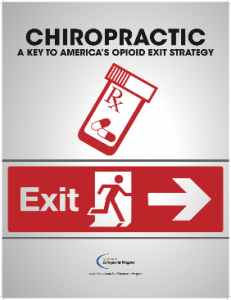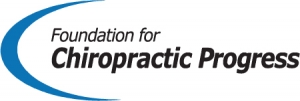Chiropractic crossing the chasm to non-pharma care
“It is a fact that a chasm exists between the worlds of pharmacologic-based management of
Crossing this chasm is the center of a new policy paper, Chiropractic: A Key to America’s Opioid Exit Strategy, from the Foundation for Chiropractic Progress that seeks to build bridges, not just for chiropractic, but all non-pharmacologic, integrative approaches. “The focus needs to shift to early applications of non-pharmacologic approaches first and not as a follow-on after the drug path has been established,” the authors write.
 The 32-page paper was released at a National Press Club event on March 14, where high profile allies from multiple agencies and
The 32-page paper was released at a National Press Club event on March 14, where high profile allies from multiple agencies and
organizations outlined the staggering burden of the opioid crisis that, according to the report, “clearly calls for a wholesale change” in the management of pain.
The authors clarify that they are not anti-opioid. In dismissing a radical anti-opioid approach, they echo a 2014 white paper from an interprofessional integrative team, Never Only Opioids. The authors argue that the direction out of the crisis “is about not turning to opioids before they are required, and not until all less onerous approaches to pain management have been exhausted.”
Gerard Clum, DC, William Meeker, DC, MPH, Laura Carabello, Sherry McAllister, DC, M.S (Ed)., CCSP, and Alexis Lignos, the authors for this paper, set the stage for chiropractic’s role as an “exit strategy,” focusing in on the importance of using non-pharmacologic agents of all kinds, first. “As a non-pharmacologic approach to effectively address acute, subacute and chronic non-cancer pain, integrative care management answers the needs of individuals nationwide,” the authors write.
 Most of the first 12 pages lay down the dimensions of the crisis. They particularly attend to the huge impact of back pain in triggering opioid prescriptions. They note that study after study, from multiple federal agencies, calls for use of non-pharmacologic approaches. “The CDC, FDA, and IOM have all called for the early use of non-pharmacologic approaches to pain and pain management.” Some, like the CDC Guideline for Prescribing Opioid for Chronic Pain, state that these should be used first.
Most of the first 12 pages lay down the dimensions of the crisis. They particularly attend to the huge impact of back pain in triggering opioid prescriptions. They note that study after study, from multiple federal agencies, calls for use of non-pharmacologic approaches. “The CDC, FDA, and IOM have all called for the early use of non-pharmacologic approaches to pain and pain management.” Some, like the CDC Guideline for Prescribing Opioid for Chronic Pain, state that these should be used first.
“Unfortunately, beyond asserting the need to move in this direction, little, if any, guidance has been offered to providers, patients and payors on how to accomplish this important transition,” the authors write.
The authors challenge some Center for Medicare and Medicaid Services recommendations as well. “While we applaud CMS, we feel it is important to point out that this approach begins with a focus on how opioids are prescribed.”
Despite calling out the critical role for non-pharmacologic approaches, “our nation is making only limited headway in providing non-pharmacologic approaches to patients with pain.”
The authors provide a guiding framework for policy makers seeking to cross the chasm via a set of three questions that must be answered for patients:
- Without the use of drugs, how will they cope with pain?
- How can they get referrals and access to drug-free care that will be effective for acute, subacute and chronic pain?
- How can they ensure that their health care plans and insurance will cover the cost of non-pharmacologic care?
 “Medical physicians are not going to suddenly attain knowledge and understanding of practices, procedures and management options that they have never been trained in or exposed to,” write the authors. “For these good intentions to be effective, drug-free pathways will need to be funded by payers in the private sector and government.”
“Medical physicians are not going to suddenly attain knowledge and understanding of practices, procedures and management options that they have never been trained in or exposed to,” write the authors. “For these good intentions to be effective, drug-free pathways will need to be funded by payers in the private sector and government.”
Much of the remainder of the report focuses on chiropractic-specific data supporting a growing role for the profession in bringing sanity to the nation’s pain treatment.
Comment: In recent years, some
Yet while the authors take us to the edge of the chasm, they missed a chance to further engage their roles as healthcare leaders. While they offer recommendations, they would have served their cause to explicitly define the policy latticework to shift the nation’s therapeutic order in pain care. What they recommend will require massive changes. The report would have benefited from a concise statement of recommendations for crossing the chasm, such as the 13 Recommendations for Policy Makers associated with the Never Only Opioids paper noted above. It’s not easy to cast aside cynicism and believe that a preferred future can emerge. Blueprints, even if aspirational, can be useful.





















SHARE